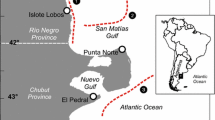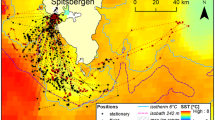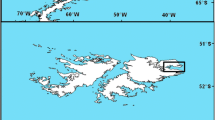Summary
In Antarctica, we investigated the energy consumption of Adélie (Pygoscelis adeliae), Gentoo (P. papua) and Chinstrap (P. antarctica) penguins while resting in the water (8.4 W-kg−1) and swimming underwater at various speeds, using a 21m long canal filled with sea-water at 4°C in conjunction with respirometry. The birds swam at will and consumed 15.7, 16.1 and 10 W·kg−1 at the speed where cost of transport was minimal (2.1, 2.3 and 2.5 m·s−1 in Adélie, Gentoo and Chinstrap penguins, respectively). Thermal conductance in pygoscelid penguins was 3.3 W·°C−1. m−2 and energy expenditure (Pi, W·kg−1) while resting in the water is given by Pj = -0.3 ta+9.6, where ta is water temperature in °C. During the breeding season, pygoscelid penguins spend 25–40% of their daily energy expenditure while foraging at sea. The importance of accurate estimates of at-sea activity and energy consumption is discussed.
Similar content being viewed by others
References
Adams NJ, Wilson MP (1987) Foraging parameters of Gentoo penguins Pygoscelis papua at Marion Island. Polar Biol 7:51–56
Ainley DG, O'Connor EF, Boekelheide RJ (1984) The marine ecology of birds in the Ross Sea, Antarctica. Berkeley, Univ California Press
Araya MB (1983) A preliminary report on the status and distribution of the Humboldt penguin in Chile. In: Delacour J (ed.) Proc IFCB Symp on breeding birds in captivity. Los Angeles pp 125–135
Bannasch R (1985) Schwimm-und Tauchleistungen der Pinguine. Milu, Berlin 6: 295–308
Brown CR (1984) Resting metabolic rate and energetic cost of incubation in Macaroni penguins (Eudyptes crysolophus) and Rockhopper penguins (E. chrysocome). Comp Biochem Physiol 77A: 345–350
Butler PJ, Woakes AJ (1984) Heart rate and aerobic metabolism in Humboldt penguins Spheniscus humboldtii during voluntary dives. J Exp Biol 108:419–428
Culik B, Wilson RP (1991) Energetics of under-water swimming in Adélie penguins (Pygoscelis adeliae). J Comp Physiol B (in press)
Culik B, Woakes AJ, Adelung D, Wilson RP, Coria NR, Spairani HJ (1990a) Energy requirements of Adélie penguin (Pygoscelis adeliae) chicks. J Comp Physiol B 160:61–70
Culik B, Adelung D, Woakes AJ (1990b) The effect of disturbance on the heart rate and behaviour of Adélie penguins (Pygoscelis adeliae) during the breeding season. In: Kerry KR, Hempel G (eds) Antarctic systems. Ecological change and Conservation. Springer, Berlin Heidelberg New York, pp 177–182
Davis RW, Croxall JP, O'Connell MJ (1989) The reproductive energetics of Gentoo (Pygoscelis papua) and Macaroni (Eudyptes crysolophus) penguins at South Georgia, South Atlantic Ocean. J Anim Ecol 58:59–74
Everson I (1977) The Southern Ocean: the living resources of the Southern Ocean. Food and Agriculture Organisation Report GLO/SO/77/1. Southern Ocean fisheries research programme, Rome, Italy
Harrison P (1983) Seabirds, an identification guide. Croom Helm, Beckenham, Kent (UK)
Hays C (1984) The Humboldt penguin in Peru. Oryx 18:92–95
Hui CA (1988) Penguin swimming. II. Energetics and behaviour. Physiol Zool 61:344–350
Kooyman GL (1975) Behaviour and physiology of diving. In: Stonehouse B (ed) The biology of penguins. MacMillan, London, pp 115–137
Kooyman GL, Gentry RL, Bergman WP, Hammel HT (1976) Heat loss in penguins during immersion and compression. Comp Biochem Physiol A 54:75–80
Lishman GS (1985) The food and feeding ecology of Adélie penguins (Pygoscelis adeliae) and Chinstrap penguins (P. antarctica) at Signy Island, South Orkney Islands. J Zool London 205:245–263
Nachtigall W, Bilo D (1980) Strömungsanpassung des Pinguins beim schwimmen unter wasser. J Comp Physiol A 137:17–26
Nagy KA, Siegfried WR, Wilson RP (1984) Energy utilization by free-ranging Jackass penguins Spheniscus demersus. Ecology 65:1648–1655
Odening K (1984) Antarktische Tierwelt. Urania, Leipzig
Oehme H, Bannasch R (1989) Energetics of locomotion in penguins. In: Wieser W, Gnaiger E (eds) Energy transformation in cells and organisms. Thieme Stuttgart
Penzlin H (1981) Lehrbuch der Tierphysiologie. Fischer, Stuttgart
Sadleir RMFS, Lay PKR (1990) Foraging movements of penguins, with emphasis on a study of Adélie penguins (Pygoscelis adeliae) in McMurdo Sound. In: Darby J, Davis LS, (eds) Penguins. Academic Press, Orlando, Florida
Schmidt-Nielsen K (1972) Locomotion: Energy cost of swimming, flying and running. Science 177:222–228
Schmidt-Nielsen K (1983) Animal Physiology: adaptation and environment. 3d edn, Cambridge University Press, London
Stonehouse B (1985) Birds and mammals-Penguins. In: Bonner WN, Walton DWH, (eds) Key environments, Antarctica. Pergamon Press, Oxford, pp 266–291
Stonehouse B (1989) Polar Ecology. Blackie, Glasgow London
Taylor JRE (1985) Ontogeny of thermoregulation and energy metabolism in pygoscelid penguin chicks. J Comp Physiol B 155:615–627
Trivelpiece WZ, Bengtson JL, Trivelpiece SG, Volkman NJ (1986) Foraging behaviour of Gentoo and Chinstrap penguins as determined by new radiotelemetry techniques. Auk 103:777–781
Trivelpiece WZ, Trivelpiece SG, Volkman NJ (1987) Ecological segregation of Adélie, Gentoo and Chinstrap penguins at King George Island, Antarctica. Ecology 68:351–361
Volkman NJ, Presler P, Trivelpiece W (1980) Diets of pygoscelid penguins at King George Island, Antarctica. Condor 82:373–378
Walsberg GE, King JR (1978) The relationship of the external surface area of birds to skin surface area and body mass. J Exp Biol 76:185–189
White MG, Conroy JWH (1975) Aspects of competition between pygoscelid penguins at Signy Island, South Orkney Islands. J Exp Biol 117:371–373
Wilson GJ (1983) Distribution and abundance of Antarctic and sub-Antarctic penguins: A synthesis of current knowledge. BIOMASS Sci Ser 4:1–46
Wilson RP, Nagy KA, Obst BS (1989) Foraging ranges of penguins. Polar Rec 25:303–307
Wilson RP, Culik B (1991) The cost of a hot meal: Facultative specific dynamic action may ensure temperature homeostasis in endotherms. Comp Biochem Physiol (in press)
Woakes AJ, Butler PJ (1983) Swimming and diving in tufted ducks Aythia fuligula, with particular reference to heart rate and gas exchange. J Exp Biol 107:311–329
Author information
Authors and Affiliations
Rights and permissions
About this article
Cite this article
Culik, B.M., Wilson, R.P., Dannfeld, R. et al. Pygoscelid penguins in a swim canal. Polar Biol 11, 277–282 (1991). https://doi.org/10.1007/BF00238463
Received:
Accepted:
Issue Date:
DOI: https://doi.org/10.1007/BF00238463




